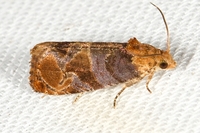Photo Gallery for Paralobesia liriodendrana - Tulip-tree Leaftier Moth | Photos: 30 |
 | Recorded by: K. Bischof on 2024-04-20
Transylvania Co.
Comment: |  | Recorded by: K. Bischof on 2024-04-20
Transylvania Co.
Comment: |
 | Recorded by: John Petranka, David George on 2023-08-05
Orange Co.
Comment: |  | Recorded by: Jim Petranka on 2023-04-21
Madison Co.
Comment: |
 | Recorded by: Vin Stanton on 2022-07-17
Buncombe Co.
Comment: |  | Recorded by: Jim Petranka on 2022-07-11
Madison Co.
Comment: |
 | Recorded by: Tracy S. Feldman on 2022-06-06
Orange Co.
Comment: |  | Recorded by: tom ward on 2022-04-25
Buncombe Co.
Comment: |
 | Recorded by: Simpson Eason on 2021-09-01
Durham Co.
Comment: |  | Recorded by: Simpson Eason on 2021-04-29
Durham Co.
Comment: |
 | Recorded by: Vin Stanton on 2020-05-26
Buncombe Co.
Comment: |  | Recorded by: Vin Stanton on 2020-05-26
Buncombe Co.
Comment: |
 | Recorded by: Jim Petranka on 2020-05-23
Madison Co.
Comment: |  | Recorded by: Jim Petranka on 2020-05-23
Madison Co.
Comment: |
 | Recorded by: Mark Shields on 2019-10-05
Onslow Co.
Comment: |  | Recorded by: David L. Heavner on 2019-08-26
Buncombe Co.
Comment: |
 | Recorded by: David L. Heavner on 2019-08-04
Buncombe Co.
Comment: |  | Recorded by: Gary Maness on 2019-06-03
Guilford Co.
Comment: |
 | Recorded by: Gary Maness on 2019-06-03
Guilford Co.
Comment: |  | Recorded by: Jim Petranka and Becky Elkin on 2019-05-18
Madison Co.
Comment: |
 | Recorded by: Jim Petranka and Becky Elkin on 2019-05-06
Madison Co.
Comment: |  | Recorded by: Jim Petranka and Becky Elkin on 2019-05-06
Madison Co.
Comment: |
 | Recorded by: Jim Petranka and Becky Elkin on 2019-04-27
Madison Co.
Comment: |  | Recorded by: Jim Petranka and Becky Elkin on 2019-04-27
Madison Co.
Comment: |
 | Recorded by: Jim Petranka and Becky Elkin on 2019-04-23
Madison Co.
Comment: |  | Recorded by: Darryl Willis on 2016-09-03
Cabarrus Co.
Comment: |
 | Recorded by: B. Bockhahn; P. Scharf, L. Amos on 2015-05-12
Warren Co.
Comment: |  | Recorded by: B. Bockhahn; P. Scharf, L. Amos on 2015-05-12
Warren Co.
Comment: |
 | Recorded by: J. Merrill Lynch on 2015-05-10
Watauga Co.
Comment: |  | Recorded by: Lori Owenby on 2011-04-23
Catawba Co.
Comment: |
|